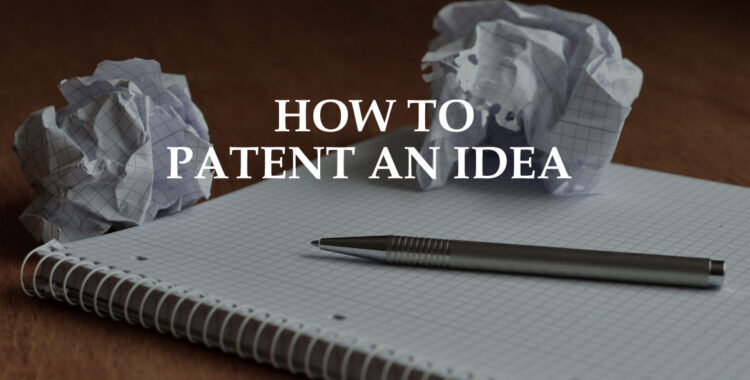How to Patent an Idea
New ideas can be priceless, but their value can hinge on the completion of the patent application process. The roadmap discussed herein will offer some insight into how a person or company obtains the intellectual rights to an innovation. Put simply, learning the steps to obtaining a patent for an idea can be an essential strategy to understand since it will enable prevent losses of potential rights while maximizing the profit from new ideas and concepts. To obtain a patent, it must be first understood that it is not an idea that is protected but an embodiment of that idea that requires the inventor to fully describe the structure, functionality, and usage of the embodiment.
What is a Patent?
A patent is a government grant that gives the inventor, or their assignee, a right to prevent others from making, selling, or using the patented invention for a fixed period – typically 20 years from the date of filing the application for utility patents and 15 years from the date of issue for design patents. The inventor must file a patent application within a year of making the invention public, or their US rights might be lost. This one-year bar date is not followed by all countries and therefore if the owner of the invention would like to protect it outside of the US, it is often important to file a patent application before doing anything public. Public acts include more than selling the device, they also include or display the device publicly and can include secret usage if that usage is tied to services being sold.
Intellectual Property Playbook
An Entrepreneur's Guide To Patents, Trademarks, and Copyrights GET THE PLAYBOOK
Why are Patents Important?
Patents ensure the rights of the inventor are protected from being utilized by others. Therefore, the owner of the patent can maximize the benefits and the revenue of exclusivity in the market.
There are three types of patents:
- Design patents – Design patents protect the appearance of an invention, for example, the ornamental features, shape, and aesthetics. A design patent expires fifteen (15) years from the date of registration.
- Utility patents – These are the most common patents. as they offer broader protection than design patents. A utility patent protects the words used to describe the invention and is most typically used to protect the method of use or the structure of an invention. They include innovations of valuable products, processes, and machines. They lapse twenty (20) years from their filing date.
- Plant patents – Though far rarer than design and utility patents, plant patents protect new variety of plants reproduced asexually.
Who can apply for a patent?
Only the true inventor of an invention can apply for a patent. This right can be assigned to others and may happen in a business setting where the inventor is an employee hired to work on innovative projects. Because only the inventor can file for a patent, others, who might see the invention, cannot legally rush to the US Patent and Trademark Office to file for protection as this would be fraud on the patent office.
Steps to Filing a Patent
1. Seek professional help
A patent attorney should typically be contacted first and foremost to determine the next steps that an inventor should take. The patent attorney will ask pointed questions about the invention to ensure that patent protection, if potentially available, is the correct route for the inventor.
It cannot be stressed enough that this is an extremely complicated area of law and requires a professional to assist the inventor. A patent needs to have a written description of your invention and is supplemented with drawings of the invention as described in the patent application. A patent attorney is crucial in drafting the description as this is highly technical and should not be attempted by non-attorneys. In fact, the United States Patent and Trademark Office (USPTO) typically discourages self-representation when filing for a patent.
The patent attorney can also assist inventors with non-disclosure agreements (NDAs) for anyone who might have access to the invention and will often have at their disposal professional patent illustrators to help develop drawings for your invention. Only trained lawyers and agents are legally allowed to prepare, file, and prosecute applications on the behalf of an inventor.
2. Determining if the invention is new
The patent attorney will nearly always recommend a prior art search to ascertain that no patent has been issued or is pending that is similar to the invention. While inventors routinely search for the idea on their own, these searches for the invention are no match for a professional prior art search which will find issued patents and pending applications not only in the United States but also across the globe as these can be cited against a patent application during the patent application process.
3. Prepare and file a patent application
A patent attorney will use all of the inventor’s drawings, descriptive writings, and pictures and videos of possible prototypes, as well as in-person discussions to write the patent application and have drawings prepared in support of the written application.
Because the process is very complicated and the experienced patent attorney understands the potential pitfalls when dealing with the USPTO, the USPTO discourages self-representation. The experienced patent attorney will not only write the application in the correct format and language but will most definitely obtain broader protection than would be obtained by a novice. We can attest that in the 20+ years since the founding of our firm, we have been unable to save any patent applications (provisional or non-provisional) written solely by the inventor.
Once the application is prepared, it is filed with the USPTO and at that point, the invention is officially “patent pending.” It is at this point that the inventor can safely use and market the invention without fear of others taking the idea. While patent pending applications do not allow an inventor to sue for infringement, they do act as a sufficient threat to keep most copiers at bay as there is no reason for another business to copy an idea only to have to deal with a patent a short time later.
4. Prosecution of transactions with the USPTO
The next step can be a long one. A patent application is often at the USPTO for at least 18 months before being picked by a patent examiner and thereafter a series of “office actions” are often issued by the patent examiner either denying wholly or in part the patent application. This is to be expected and the patent attorney will submit counter-arguments for patentability for each argument against.
The process of being denied on the first action should not be taken as a verdict against obtaining a patent because the USPTO is set up in such a way to challenge patentability for the purpose of ensuring only new inventions are awarded patents. Therefore, the application being rejected is not the end of the road for the patent and the majority of patent applications initially rejected find a path to becoming a patent. If the Patent Examiner will not change their position, there is also the possibility of appealing the decision over their head to the appeal board at the USPTO or to a federal court.
Once the application is allowed, it will be issued after the issue fee is paid and thereafter is maintained with payments made at 3.5, 7.5, and 11.5 years after issuance.
Hire an Experienced Patent Lawyer
Once an invention is created – on paper or in a prototype – it is important that the inventor take the necessary steps to protect it, potentially with a patent, to maximize its potential and protect it from being copied or stolen. Contacting a patent lawyer should be done as early in the process as possible and well before the application process to reduce the risks of losing any potential rights.






